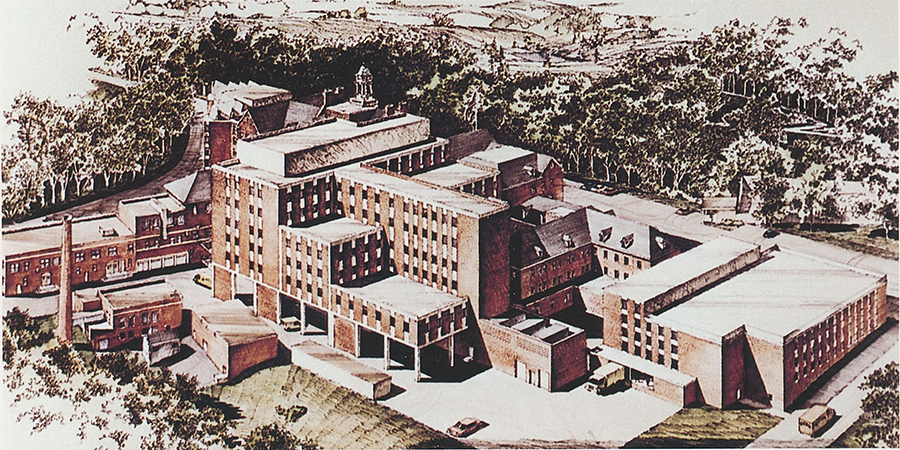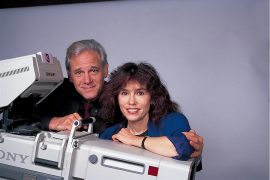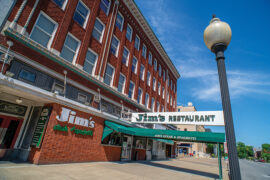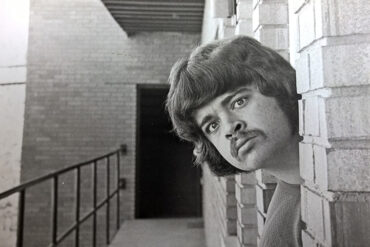MU’s School of Medicine is the catalyst that’s made Huntington the regions’ health care Mecca
By Beverly McCoy
HQ 3 | SPRING 1990
Debbie Payne doesn’t care why the Huntington medical community is a major referral center for three states. She only cares that it saved her baby’s life.
Her son Jesse was born with a rare bowel obstruction. The beginning of his intestine was there, and so was the last one-third – but there was nothing in between. Debbie and her husband, Eric, had learned through prenatal testing there would be a problem. After being operated on, the physician told Debbie and Eric that he had taken some temporary steps and recommended a treatment plan – but told them there was an 85 percent chance their baby would die. “I immediately went for a second opinion’,” recalled Debbie. Jesse’s pediatrician recommended West Virginia’s only board-certified pediatric surgeon, Dr. Stephen Wolf of the Marshall University School of Medicine.
Wolf was indeed able to correct the baby’s problem, but it was painstaking work. “We had some tough moments the first two or three days, but it worked perfectly,” Wolf said. ‘Jesse is a fighter which stood him in good stead.”
“Nothing they did seemed to faze him,” his mother recalled. “He was going to make it.”
Far-Reaching Impact
For the Paynes and thousands like them, the growing strength of the Huntington medical community has meant they can find es ential care close to home; for some, those services have meant life itself. For those people and others, the medical community’s strength also has meant increased health-care choices and the benefits of economic growth in the area. The Huntington Herald-Dispatch credits the Marshall University School of Medicine with being a catalyst for increased medical growth in Huntington during the past 15 years.
“Over the years, the Tri-State Area has seen many milestones,” the paper said in a 1988 editorial. “But few, if any, dates in the region’s history are more important than January 1978, when the new Marshall University School of Medicine admitted its first future doctors, for the medical school literally has revolutionized health care here.”
The editorial went on to call the medical school “a magnet attracting highly trained personnel and sophisticated medical resources to our region, transforming it into a major regional center for medical care.”
The groundwork establishing Huntington as a regional health-care center dates back decades, led by the pioneering efforts of the C&O Railroad Hospital and enhanced by the leadership of St. Mary’s Hospital and Cabell Huntington Hospital.
Huntington’s strong, progressive medical community provided the ideal setting for the birth of a medical school designed to join its efforts with those of an entire community.

The Cabell County Medical Society and the community helped create a new kind of medical school, one that American Medical Association Vice President Leonard Fenninger predicted in 1983 could become the direction of the future in medical education. The years have proved him right: Today, a number of medical schools are actually selling their university hospitals and instead developing cooperative working relationships with community hospitals.
The outcome for the Tri-State has meant more doctors, specialists and top-notch medical care.
Care “Comparable to Anywhere”
“The medical care available in Huntington really supersedes what you would anticipate for our region and the size of our population,” said Charles McKown Jr., dean of the medical school. “Someone from the outside looking in would find in Huntington a scope, diversity, depth and excellence in medical care com parable to that found anywhere in the United States.”
Since the medical school’s creation, St. Mary’s Hospital and Cabell Huntington Hospital have been able to offer valuable new services: open-heart surgery, a burn unit, advanced cancer treatment services, special intensive care units for infants and children and a joint trauma service – just for starters. The hospitals’ administrators call Marshall’s medical school an important contributor to this process.
“The school of medicine and medical education set St. Mary’s and Cabell Huntington apart from other hospitals in our area and region,” said J. Thomas Jones, executive director and C.E.O. of St. Mary’s Hospital. “We have medical students, we’re training physicians. We have to be on the cutting edge. It keeps everybody sharp and provides the impetus for high-quality care.”
Don Smith, executive director of Cabell Huntington Hospital, compared Huntington’s medical community to a three-legged stool, with each leg vital to the community’s success: excellent hospitals, highly qualified private physicians, and the medical school with its ability to bring in specialists that Huntington could not otherwise attract.
Nowhere is the accelerated progress of the community more apparent than in Huntington’s magnetic resonance imaging facility, which resulted from remarkable community-wide determination and cooperation.
The process of MRI, as it is called, offers doctors a remarkable new way to peer into the human body going beyond X-rays and Cat scans in its ability to find out what is happening inside the body.
Meeting Special Needs
The medical school’s presence has brought great benefits to groups with special needs.
High on that list are the Armed Services veterans of the region. More than a third of West Virginia’s veterans live in the region served by the Huntington VA Medical Center. If veterans in the Ohio and Kentucky segments of the service area are added, the number of veterans served exceeds the combined populations of Huntington and Charleston.
Before the VA-affiliated medical school was created, the Huntington VA Medical Center had just 20 doctors, and most of them were not board-certified in their specialities. Today the center has more than 50 physicians, nearly all of them with board certification.
Paralleling the dramatic improvement in services is an equally impressive improvement in facilities. In the 1970s the VA invested millions in building a new hospital wing and extensively renovating facilities; now the center is in the midst of a $4 7 .5 million expansion project that will improve surgical facilities, add a cardiac catherization lab, create an inpatient psychiatric service, and increase the center’s capacity to 250 inpatients.
“Our partnership with Marshall University is absolutely essential to delivering health care to veterans in this part of West Virginia, and we are also an essential teaching resource for the school of medicine,” said Philip Elkins, director of the VA Medical Center.
The school of medicine helps meet the unique health needs of elderly West Virginians through two widely differing programs: the Hanshaw Geriatric Center and a rural geriatrics demonstration project.
The Hanshaw Geriatric Center, funded by a $1 million grant from the Huntington Foundation, is the only free-standing geriatric center in West Virginia.
The rural geriatric demonstration project, based in Lincoln County, has set out to prove that elderly people can maintain their independence longer with the help ofa program that stresses preventive health care and close attention to the home and family environment.
At the other end of the age spectrum, the School of Medicine has helped Mountain State infants and children through innovative, effective prenatal care programs and through the recruitment of specialists in such fields as neonatology, pediatric surgery, and pediatric cardiology.
Finally, the medical school’s doctors lend a helping hand to those who need it most: the uninsured and underinsured. Each y_ear the school provides approximately $2.4 million worth of unreimbursed care through John Marshall Medical Services alone.
Marshall’s medical school contributes to the economic health of the region as well.
For example, the School of Medicine is one of Huntington’s top 20 employers, providing hundreds of jobs with a payroll of about $11 million.
The school’s total dollar impact on Cabell and Wayne counties exceeds $53 million a year. The taxes generated by this activity repay nearly one dollar out of every three the state appropriates for the school.

Businessman Edgar Shaffer of Wilson Welding Company speaks from experience. “You’re a real asset to our community,” he said in a letter to Department of Medicine Chairman Maurice Mufson praising that departments cardiology services.
As a businessman, Shaffer said he particularly appreciated the prompt service he received. “It’s very gratifying to get in and out quickly,” he said later. “I like my time. I have my work to do during the week, and that’s the time other people need to reach me.”
As a patient, Shaffer also appreciated the fact that everyone from the receptionist to the chief of cardiology was, in his words, “down home friendly.”
“You don’t know what that means,” he said. “The personal treatment was beyond anything I’ve ever received. It was a shock, but a pleasant one.”
“As a businessman, the presence of a medical school is very attractive to me, and it would be if I was planning to move a business -which I’m not,” he added. “It could be a swaying point. If everything else was equal between two’ smaller communities and one had a medical school, it could be a huge factor, believe me.”
It is impossible to qualify how the school of medicine’s activities have contributed to major expansions at St. Mary’s and Cabell Huntington hospitals. There is no such difficultv in drawing a connection to dramatic growth at the VA Medical Center, however. The current $47.5 million expansion and millions of dollars worth of improvements in the 1970s can be traced directly to the med school affiliation. In addition to the construction dollars, the current expansion program alone is expected to create more than 250 permanent jobs for the Huntington area.
Marshall’s medical research programs also contribute to both the region’s physical health and fiscal health.
Dr. Gary Rankin, the associate dean who oversees the program, said “Marshall’s research projects are bringing in grant money that in most cases goes to create new jobs and to produce goods and services,”
For years, MU was known primarily for its vaccine and AIDS research. Although some work continues in those areas, the schools emphasis has broadened to encompass strong projects in such fields as hypertension, diabetes and geriatrics. In addition, faculty members seek and receive outside grants to help support teaching innovations. For example, the school now is receiving half a million dollars from the federal government to explore ways to better prepare young doctors to help prevent heart disease in their patients.
Marshall’s projects are as varied as its researchers. Rankin focuses on toxicology, studying how and why certain chemical compounds damage the kidneys. Some of his fellow basic science researchers are doing laboratory studies on high blood pressure, lung function, breast cancer and recovery from burns.
Physician researchers, with grants from the National Institutes of Health and the U.S. Department of Veterans Affairs, are studying problems ranging from growth hormone abnormalities to diabetes to viral respiratory illness.
“At a medical school you train physicians, you don’t train technicians,” he said. “An important part of teaching students how to think through medical problems is to provide them with research experience where they take a problem, work through it and solve it.
“By giving students exposure to research we’ re also teaching them how to deal with the challenges of practicing in rural West Virginia, where they don’t have all the latest equipment or the ability to run every possible test,” he added. “A background in research helps make them more creative.”
Huntington’s medical leaders have a busy agenda mapped out for the coming months and years. All contributors to the “three-legged stool” supporting Huntington medicine are working to strengthen the city’s position as a regional referral center for advanced care.
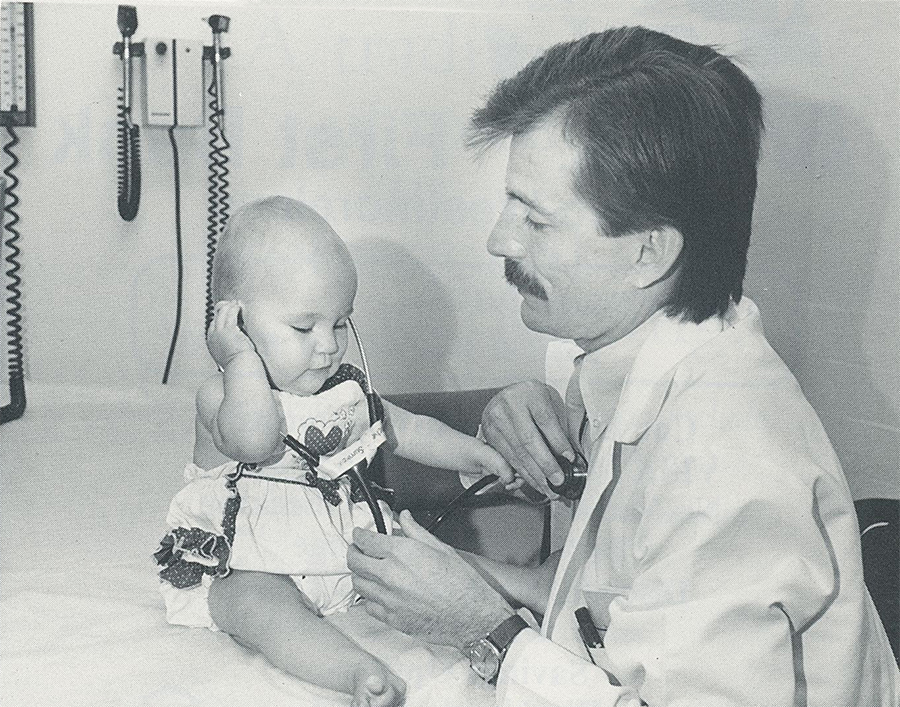
The partners have individual goals as well.
At Cabell Huntington, work on a$12.5 million surgical addition already is under way and is expected to be completed by early 1991. The hospital plans to renovate its obstetrics department and continue its educational and service focus on women’s health. The hospital also will work to further strengthen its pediatrics program and provide occupational health services.
St. Mary’s will be exploring buildings and programming designed to serve outpatients and expand its wellness and preventive health programs, both for the general community and for senior citizens. It plans to move outside its own walls and into the community, providing corporate medicine and occupational medicine where needed.
Marshall’s medical school is teeming with activity, too, as it works to recruit the specialists needed to provide new kinds of medical care to the people of Huntington. On an ongoing basis, it will be continuing its research programs, exploring educational innovations, and extending its network of rural outreach. The coming years will bring a new state-of-the-art outpatient care center. In addition, the school will be expanding its services to senior citizens through the Hanshaw Geriatric Center.
“There can be no question that this is one of the busiest periods in Huntington’s medical history,” said Dean McKown. “We believe it’s going to be one of the most productive as well.
“The beneficiaries,” he added, “will be the people of Huntington and the Tri-State region, who know that in Huntington they are getting the most advanced, top-quality medical care available, along with the caring atmosphere that has become the trademark of health care here.”

